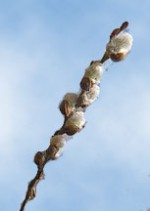Pussy willow is a deciduous shrub or small tree native to moist and wet soils of northern regions of North America including parts of the US. It is a member of the willow family, Salicaceae, that also includes poplar, aspen, and cottonwood. The plants grow 6-15′ tall and have brown shoots and oval leaves that are 1-5.5″ long, green above and downy grey-below. Before the leaves emerge, male and female catkins appear on different plants. The male catkins are up to 1″ long, silky, pearly gray, and produce copious amounts of pollen that is attractive to bees. The fruit is a capsule less than .5″ long and contains numerous minute seeds embedded in cottony down. The male catkins are larger and more attractive than the female catkins and are prized for floral arrangements. They can be forced into bloom inside for arrangements in winter and can be last for years if dried slowly. The plants can be used as a hedge or wind break especially near ponds, lakes, streams, and rivers. The genus name, Salix, is the ancient Latin name for one of the species. The specific epithet, discolor, is from the prefix dis- meaning lack of or not, and the Latin word colare, meaning to color.
Type: Deciduous shrub or small tree.
Outstanding Feature: Fuzzy pearl gray male catkins in late winter to early spring.
Form: Upright, irregular.
Growth Rate: Rapid
Bloom: Yellow stamens produce color on otherwise insignificant flowers.
Size: 6-15’ H x 4-12’ W.
Light: Prefers full sun but tolerates some shade.
Soil: Medium to wet well drained sandy loam; intolerant of dry soil.
Hardiness: Zones 4-8.
Care: May be cut back to the ground every 3-5 years to control size and promote longer stems and larger catkins. Catkins are produced on previous year’s growth so prune after flowering.
Pests and Diseases: Susceptible to blights, powdery mildew, leaf spots, gray scab, cankers, aphids, scale, borers, lacebugs and caterpillars. Like other willows, the wood is weak and branches may be broken by ice and snow.
Propagation: Cuttings root very easily especially in spring; cut pieces of stem about the diameter of a pencil and sick them in the soil. Seeds are viable for only a few weeks after maturing.
Comments: Rapidly growing shallow root system may block sewers and drains.
Photo Credit: Wikipedia

